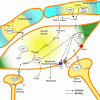Sainz J, Rudolph A, Hoffmeister M, et al. Effect of Type 2 Diabetes Predisposing Genetic Variants on Colorectal Cancer Risk. Journal of Clinical Endocrinology & Metabolism. Effect of Type 2 Diabetes Predisposing Genetic Variants on Colorectal Cancer Risk
Background: The link between colorectal cancer (CRC) and type 2 diabetes mellitus (T2D) has been extensively studied. Although it is commonly accepted that T2D is a risk factor for CRC, the underlying mechanisms are still poorly understood.
Research Design and Methods: Given that the genetic background contributes to both traits, it is conceivable that genetic variants associated with T2D may also influence the risk of CRC. We selected 26 T2D-related single-nucleotide polymorphisms (SNP) previously identified by genome-wide association studies and assessed their association with CRC and their interaction with known risk factors (gender, T2D, and body mass index) of CRC. Selected SNP were genotyped in 1798 CRC cases and 1810 controls from the population-based Darmkrebs: Chancen der Verhütung durch Screening (DACHS) study (Germany).
Results: Patients carrying the TCF7L2_rs7903146_T allele had an increased risk of CRC (Ptrend = 0.02), whereas patients harboring the IL13_rs20541_T allele had a reduced risk (Ptrend = 0.02). A further analysis revealed gender-specific effects: the TCF7L2_rs7903146_T allele was associated with an increased risk of CRC in women (Ptrend = 0.003) but not in men (Pinteraction = 0.06); theLTA_rs1041981_A allele was associated with a decreased risk for CRC in women (Ptrend = 0.02), with an opposite effect in men (Ptrend = 0.05; Pinteraction = 0.002); the CDKAL1_rs7754840_C allele was associated with a decreased risk for CRC in men (Ptrend = 0.03), with no effect in women (Pinteraction = 0.03). The risk associated with the presence of T2D was modified both by IGF2BP2_rs4402960 andPPAR?_rs1801282 SNP (Pinteraction = 0.04 and 0.04, respectively). None of the findings were significant after correction for multiple comparisons.
Conclusions: These findings suggest that T2D-related variants modify CRC risk independently and/or in an interactive manner according to the gender and the presence or absence of T2D.
Background: The link between colorectal cancer (CRC) and type 2 diabetes mellitus (T2D) has been extensively studied. Although it is commonly accepted that T2D is a risk factor for CRC, the underlying mechanisms are still poorly understood.
Research Design and Methods: Given that the genetic background contributes to both traits, it is conceivable that genetic variants associated with T2D may also influence the risk of CRC. We selected 26 T2D-related single-nucleotide polymorphisms (SNP) previously identified by genome-wide association studies and assessed their association with CRC and their interaction with known risk factors (gender, T2D, and body mass index) of CRC. Selected SNP were genotyped in 1798 CRC cases and 1810 controls from the population-based Darmkrebs: Chancen der Verhütung durch Screening (DACHS) study (Germany).
Results: Patients carrying the TCF7L2_rs7903146_T allele had an increased risk of CRC (Ptrend = 0.02), whereas patients harboring the IL13_rs20541_T allele had a reduced risk (Ptrend = 0.02). A further analysis revealed gender-specific effects: the TCF7L2_rs7903146_T allele was associated with an increased risk of CRC in women (Ptrend = 0.003) but not in men (Pinteraction = 0.06); theLTA_rs1041981_A allele was associated with a decreased risk for CRC in women (Ptrend = 0.02), with an opposite effect in men (Ptrend = 0.05; Pinteraction = 0.002); the CDKAL1_rs7754840_C allele was associated with a decreased risk for CRC in men (Ptrend = 0.03), with no effect in women (Pinteraction = 0.03). The risk associated with the presence of T2D was modified both by IGF2BP2_rs4402960 andPPAR?_rs1801282 SNP (Pinteraction = 0.04 and 0.04, respectively). None of the findings were significant after correction for multiple comparisons.
Conclusions: These findings suggest that T2D-related variants modify CRC risk independently and/or in an interactive manner according to the gender and the presence or absence of T2D.



